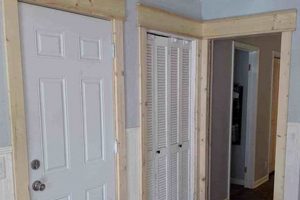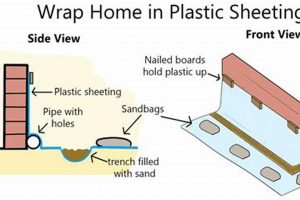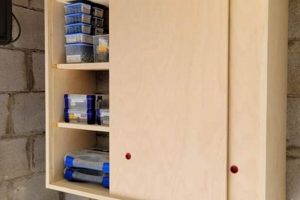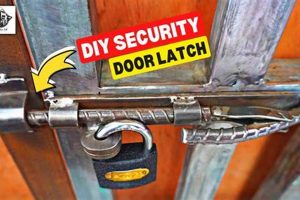The process of independently constructing an entryway for a backyard storage structure involves a range of skills and considerations. This includes selecting suitable materials, accurately measuring dimensions, and employing appropriate construction techniques to ensure a functional and aesthetically pleasing result. For example, someone might choose to build a simple, framed door using readily available lumber and basic tools, or opt for a more elaborate design incorporating advanced joinery and finishing.
Such an undertaking offers several advantages. It allows for customization to precisely fit the shed’s opening, catering to specific storage needs and design preferences. Furthermore, it can be a cost-effective alternative to purchasing a pre-made door, especially when utilizing reclaimed or readily sourced materials. Historically, self-built structures have been a cornerstone of resourcefulness and self-sufficiency, empowering individuals to create practical solutions tailored to their individual circumstances.
This article will examine key aspects of this construction activity, encompassing material selection, framing techniques, hinge and latch installation, and finishing options. It will provide a guide to successfully completing the construction process, ensuring a durable and well-functioning entryway for the storage structure.
Construction Advice
The following points offer critical guidance for ensuring the successful fabrication and installation of a custom-built entryway for a backyard storage unit.
Tip 1: Material Selection. Prioritize weather-resistant lumber such as cedar, redwood, or treated pine to mitigate rot and insect damage. The selected material directly affects the structure’s longevity.
Tip 2: Precise Measurements. Accurately measure the shed’s opening dimensions before commencing construction. Employing a level and square ensures proper alignment and prevents binding or gaps.
Tip 3: Frame Construction. Utilize robust joinery techniques, such as mortise-and-tenon or pocket-hole screws, to create a strong and stable frame. The frame’s integrity is paramount to the door’s overall performance.
Tip 4: Hinge Selection. Choose hinges rated for exterior use and capable of supporting the door’s weight. The number and placement of hinges should evenly distribute the load.
Tip 5: Weather Stripping Installation. Applying weather stripping around the perimeter creates a weathertight seal, preventing water intrusion and drafts. Proper installation enhances the storage unit’s climate control.
Tip 6: Latch and Lock Mechanisms. Select a durable latching system to secure the entryway. Consider a lockable mechanism for added security against unauthorized access.
Tip 7: Finishing Techniques. Apply a weather-resistant sealant, stain, or paint to protect the wood from the elements. Proper finishing extends the wood’s lifespan and improves its aesthetic appeal.
Adhering to these recommendations contributes to a durable, functional, and aesthetically pleasing addition to the storage structure, maximizing its utility and lifespan.
The following section will address common challenges and troubleshooting techniques encountered during the creation process.
1. Precise Measurements
Accurate dimensional planning constitutes a foundational element in the successful fabrication of an entryway for a backyard storage unit. Imprecise measurements can lead to functional defects, structural instability, and aesthetic compromises. Thorough and accurate measurement practices are therefore paramount.
- Opening Alignment
Accurate measurements ensure the constructed entryway properly aligns with the shed’s opening. Misalignment leads to operational difficulties, such as binding or sticking, and compromises weather sealing. For instance, if the opening is wider at the top than the bottom, a rectangular entry may not seat correctly, leaving gaps.
- Material Optimization
Precise measurements minimize material waste by ensuring accurate cutting and assembly. This reduces construction costs and promotes resource efficiency. Consider a scenario where measurements are overestimated, resulting in excess lumber needing disposal, or are underestimated, necessitating purchasing additional materials.
- Structural Integrity
Correct dimensions are critical for maintaining the structural integrity of the framed structure. Inaccurate measurements can result in weak joints or uneven weight distribution, potentially leading to premature failure. For example, a door frame built with incorrect angles could warp or collapse under its own weight.
- Hardware Compatibility
Accurate measurements facilitate proper installation of hardware, such as hinges and latches. Incorrect dimensions can prevent hardware from functioning correctly or compromise its security. An entryway built too narrowly may prevent proper hinge placement, impacting its ease of opening and closing.
The cumulative effect of meticulous dimensional planning contributes significantly to the overall quality and longevity of the shed entryway. Diligent application of precise measurement techniques minimizes the likelihood of costly errors and ensures a functional and aesthetically pleasing addition to the storage unit. The implementation of accurate dimensions is therefore a non-negotiable aspect of the creation process.
2. Durable Material Selection
The selection of appropriate materials is a crucial determinant in the success of independently constructing an entryway for a storage structure. Material durability directly impacts the entryway’s resistance to environmental factors, its longevity, and its overall performance. Choosing inappropriate materials can lead to premature failure and increased maintenance requirements.
- Weather Resistance
Exterior structures are continuously exposed to moisture, sunlight, and temperature fluctuations. Durable materials, such as treated lumber or certain hardwoods, exhibit superior resistance to rot, warping, and insect infestation. Untreated pine, for example, is susceptible to decay when exposed to moisture, whereas cedar possesses natural oils that offer inherent protection. The selection must prioritize materials capable of withstanding local climatic conditions to minimize degradation.
- Structural Integrity
The selected material must possess sufficient strength to support the weight of the entryway and withstand forces exerted during operation (opening and closing). Softwoods may be adequate for smaller, lightweight structures, while hardwoods or reinforced composites are preferable for larger, heavier applications. Consider the structural demands imposed by high winds or potential impact damage; weaker materials risk failure under stress.
- Maintenance Requirements
Certain materials necessitate more frequent maintenance than others. Wood, for instance, typically requires periodic sealing or painting to prevent moisture intrusion and UV damage. Metal structures may require rust prevention measures. Selecting a durable material with low maintenance requirements reduces the long-term cost and effort associated with upkeep. Composite materials, for example, offer resistance to weathering and insect damage with minimal upkeep.
- Cost-Effectiveness
While durability is paramount, material selection must also consider cost constraints. More durable materials often command a higher initial price. However, their extended lifespan and reduced maintenance requirements may offset the initial investment over time. Balancing durability with budgetary limitations is essential. Sourcing reclaimed materials can provide a cost-effective alternative without sacrificing quality.
The convergence of these facets underscores the pivotal role of meticulous material assessment in any independent construction endeavor. A holistic approach, considering weather resistance, structural demands, maintenance implications, and budgetary realities, ensures a durable and long-lasting entryway for the backyard storage structure, offering functional utility and long-term value.
3. Robust Frame Construction
The structural integrity of an independently constructed shed entryway is fundamentally dependent on the robustness of its frame. The frame serves as the foundational support system, bearing the weight of the entryway, resisting environmental stresses, and ensuring proper functionality over time. Consequently, meticulous attention to frame construction is paramount for the success of any such project.
- Joint Integrity
The type and execution of joinery significantly impact frame strength. Techniques like mortise-and-tenon, lap joints, or reinforced butt joints with fasteners are crucial for creating a rigid and stable structure. For instance, a frame relying solely on nails may weaken over time due to vibration and weather exposure, while a frame using mortise-and-tenon joints offers superior resistance to racking forces. The chosen joinery method must be appropriate for the size and weight of the entryway.
- Material Selection for Framing
While the overall material of the entryway impacts durability, the material used specifically for the frame is of critical importance. Using lumber that is straight, free of knots, and adequately treated for outdoor exposure is essential. Warped or knotty lumber can compromise the squareness and stability of the frame, leading to operational problems. Similarly, untreated lumber is susceptible to rot and insect damage, weakening the frame over time.
- Squareness and Alignment
A precisely square and aligned frame ensures that the entry functions smoothly and seals properly against the shed opening. Deviations from square can cause binding, sticking, and gaps that allow water and pests to enter. Utilizing framing squares and levels during construction is essential for maintaining accuracy. Even minor imperfections can accumulate and negatively impact the overall performance.
- Bracing and Reinforcement
Incorporating bracing or reinforcement elements within the frame enhances its resistance to distortion and stress. Diagonal braces, corner blocks, or metal straps can significantly improve the frame’s stability, particularly in larger or heavier entryways. Such reinforcement is especially important in areas prone to high winds or seismic activity.
In essence, robust frame construction forms the bedrock of a successful, independently-built shed entryway. Through careful material selection, precise joinery, attention to squareness, and strategic reinforcement, the frame can withstand the rigors of the external environment, providing enduring functionality and security to the storage structure. Neglecting the frame’s importance will compromise the entire project, resulting in a structure that is prone to failure and necessitates costly repairs.
4. Secure Hinge Placement
Secure hinge placement constitutes a critical element in the successful independent construction of a shed entryway. The strategic positioning and secure attachment of hinges directly influence the entryway’s functionality, durability, and long-term performance. Inadequate hinge placement can lead to operational difficulties, structural instability, and premature failure, rendering the entryway unusable.
- Weight Distribution and Load Bearing
Hinge placement must effectively distribute the weight of the entryway across the supporting structure. Incorrect placement can concentrate stress on individual hinges, leading to premature wear or failure. Heavier entryways necessitate the use of additional hinges or larger, more robust hinge designs. The distance between hinges should be optimized to evenly distribute the load and prevent sagging or binding. For example, a tall, heavy entryway may require three hinges strategically positioned to support its weight and ensure smooth operation.
- Frame and Structure Integrity
Hinges must be securely anchored to both the entryway frame and the shed structure. Insufficient anchoring can compromise the stability of the entire system, leading to misalignment or detachment. Using appropriate fasteners (screws or bolts) of sufficient length and strength is essential. Pre-drilling pilot holes can prevent wood splitting and ensure a secure connection. Furthermore, reinforcing the attachment points with backing plates or solid wood blocks can enhance the hinge’s holding power, especially in areas prone to high winds or impact.
- Alignment and Smooth Operation
Precise hinge alignment is crucial for ensuring smooth and effortless operation of the entryway. Misaligned hinges can cause binding, sticking, or difficulty in opening and closing. Using a level and a straight edge during installation is essential for maintaining proper alignment. Adjusting hinge placement slightly can often correct minor misalignments. Additionally, lubricating the hinges periodically can further enhance smooth operation and prevent corrosion.
- Security and Resistance to Forced Entry
While hinges primarily serve a functional purpose, their placement also impacts the entryway’s security. Exposed hinge pins can be vulnerable to tampering, allowing unauthorized access. Using security hinges with non-removable pins or concealing the hinges altogether can enhance the entryway’s resistance to forced entry. Furthermore, reinforcing the surrounding frame and structure can prevent an intruder from simply prying the entryway off its hinges.
The strategic and secure placement of hinges directly correlates with the overall success of any independently constructed shed entryway. Careful consideration of weight distribution, structural integrity, alignment, and security ensures that the entryway functions flawlessly, withstands environmental stresses, and provides lasting utility to the storage structure. Proper hinge installation, therefore, represents an indispensable component of a well-executed project, contributing significantly to the structure’s durability and functionality.
5. Weather-Resistant Finishing
Weather-resistant finishing is an indispensable component of any successful independently constructed shed entryway. Given its continuous exposure to environmental elements, neglecting proper finishing invites premature degradation, ultimately compromising structural integrity. The direct effect of inadequate finishing is accelerated decay, warping, and diminished aesthetic appeal. For instance, a shed entryway constructed from untreated lumber in a region with high humidity will exhibit signs of rot and fungal growth within a relatively short timeframe. The application of weather-resistant coatings or sealants mitigates this risk, providing a protective barrier against moisture, ultraviolet radiation, and temperature fluctuations. Therefore, weather-resistant finishing directly dictates the long-term viability and functional efficacy of a independently constructed shed entryway.
Consider a scenario where two identical shed entryways are constructed, one receiving a comprehensive weather-resistant treatment and the other left unfinished. Over the course of several seasons, the untreated entryway will display visible signs of weathering, including discoloration, cracking, and potential warping. The treated entryway, conversely, will maintain its structural integrity and aesthetic appeal, requiring only minimal maintenance to sustain its protective layer. The practical significance of this distinction becomes evident when considering the cost of repairs or complete replacement of the degraded entryway, compared to the relatively minor investment in proper finishing materials and application. Furthermore, weather-resistant finishing extends beyond mere surface protection; it also contributes to the overall stability of the structure by preventing moisture-induced expansion and contraction, which can weaken joints and connections.
In conclusion, the integration of weather-resistant finishing into the shed entryway fabrication process is not merely an optional enhancement but a fundamental requirement for ensuring its longevity and reliable functionality. The challenges associated with selecting the appropriate finishing materials and application techniques are minimal compared to the potential consequences of neglecting this crucial step. The selection of suitable primers, paints, stains, or sealants, tailored to the specific wood type and environmental conditions, reinforces the structure’s resistance to degradation. Consequently, weather-resistant finishing stands as a critical aspect of independently constructing durable and sustainable shed entryways, underscoring its inseparable link to the overall longevity and utility of the structure.
6. Effective Sealing Methods
The successful independent construction of a shed entryway is inextricably linked to the employment of effective sealing methods. The function of a shed, primarily storage, necessitates a controlled internal environment, shielded from the external elements. The entryway, as a point of ingress and egress, represents a potential vulnerability in maintaining this controlled environment. Poorly sealed entryways permit moisture, insects, and drafts to infiltrate the shed, potentially damaging stored contents and accelerating the decay of the structure itself. Consequently, the implementation of proper sealing techniques is a critical component of the overall project. A properly sealed entryway minimizes environmental intrusion, protects stored items, and enhances the longevity of the entire shed structure. The failure to adequately seal an entryway can negate the benefits of other careful construction techniques, such as robust framing and durable material selection. As an illustrative instance, consider a shed constructed with pressure-treated lumber and a well-built frame. If the entryway is not properly sealed, rainwater can seep in, leading to dampness and promoting mold growth, rendering the shed unsuitable for storing sensitive materials such as textiles or electronics.
The application of effective sealing methods encompasses several key aspects. These include the installation of weather stripping around the perimeter of the entryway, the application of caulk to fill gaps and seams, and the proper fitting of the entryway within its frame. Weather stripping acts as a physical barrier, preventing air and moisture from passing through the gaps between the entryway and the frame. Caulk fills in any remaining cracks or openings, creating a watertight seal. A well-fitted entryway, constructed with precise measurements, minimizes the gaps that require sealing in the first place. In practical application, the installer should ensure that the weather stripping is properly adhered to the frame, creating a continuous seal around the entire entryway. The caulk should be applied smoothly and evenly, filling all gaps without leaving any voids. The proper fit of the entryway within the frame requires careful adjustment and shimming, ensuring that it closes tightly and evenly against the weather stripping. Furthermore, the choice of sealing materials should be appropriate for the environment and the materials used in the entryway’s construction. For example, silicone caulk is generally more resistant to moisture and UV degradation than acrylic caulk, making it a better choice for exterior applications. Similarly, the type of weather stripping selected should be compatible with the material of the entryway and the frame, ensuring a long-lasting and effective seal.
In summary, effective sealing methods are not merely an afterthought but a fundamental consideration in the construction of a functional and durable shed entryway. The meticulous application of weather stripping and caulk, combined with a precise fit, directly contributes to the preservation of the shed’s internal environment, protecting stored contents and extending the lifespan of the structure. Overcoming the challenge of achieving a complete and lasting seal necessitates careful planning, precise execution, and the selection of appropriate materials. The proper understanding and application of these techniques transforms a potential point of weakness into a reliable barrier, ensuring the long-term utility and value of the independently constructed shed entryway.
7. Reliable Latching System
A reliable latching system is a critical and integral component of any independently constructed shed entryway. The function of this system extends beyond simply keeping the entryway closed; it contributes directly to the security, weather resistance, and overall longevity of the shed structure. A poorly designed or implemented latching mechanism can negate the benefits of a well-built entryway, rendering the shed vulnerable to intrusion, environmental damage, and functional failure. The selection and installation of a reliable latching system, therefore, demands careful consideration and meticulous execution as part of any door for shed diy project.
The practical significance of this understanding can be illustrated through various scenarios. Consider a shed used for storing valuable gardening tools. A flimsy latching system could be easily bypassed, leading to theft and financial loss. Alternatively, a shed located in an area prone to high winds requires a robust latching system to prevent the entryway from being blown open, which could cause damage to the entryway itself, the shed structure, and any stored contents. The selection of a suitable latching system should be informed by factors such as the shed’s intended use, its location, and the overall security requirements. Furthermore, the chosen system must be durable and weather-resistant to ensure reliable performance over time. Simple hasps and padlocks, for instance, may suffice for basic security needs, while more sophisticated deadbolt or multi-point locking systems offer enhanced protection. The installation process should also be executed with precision, ensuring that the latch engages securely and the mounting hardware is appropriately sized and fastened to prevent loosening or failure.
In conclusion, the incorporation of a reliable latching system is not merely an optional addition to a door for shed diy project; it is an essential element that directly impacts the shed’s functionality, security, and long-term value. Overcoming the challenges associated with selecting and installing an appropriate system requires careful planning, informed decision-making, and meticulous execution. By prioritizing the reliability of the latching mechanism, the shed owner can ensure the protection of their stored items, the structural integrity of their shed, and the overall effectiveness of their independent construction endeavor.
Frequently Asked Questions
The following section addresses common inquiries regarding the design and construction of entryways for backyard storage structures. The aim is to provide concise, factual answers to prevalent concerns, facilitating informed decision-making.
Question 1: What is the most suitable lumber for constructing a shed entryway intended for outdoor use?
Weather-resistant lumber such as cedar, redwood, or pressure-treated pine is advisable. These materials exhibit inherent resistance to rot, insect infestation, and moisture damage, prolonging the structure’s lifespan.
Question 2: How does one ensure the shed entryway is square during construction?
Employ a framing square to verify that all corners are precisely 90 degrees. Utilize diagonal measurements; the diagonals should be equal if the frame is square. Make adjustments as necessary before permanently fastening the frame components.
Question 3: What is the recommended method for attaching hinges to the shed entryway and frame to ensure maximum stability?
Employ screws of appropriate length and gauge. Pre-drilling pilot holes prevents wood splitting. Consider using longer screws that penetrate into the framing members of the shed structure for increased support.
Question 4: How does one effectively seal a shed entryway to prevent water intrusion and air leaks?
Install weather stripping around the perimeter of the entryway where it contacts the frame. Apply caulk to any gaps or seams. Ensure the entryway fits snugly within the frame. Regularly inspect and replace weather stripping and caulk as needed.
Question 5: What type of latching mechanism is most suitable for securing a shed entryway against unauthorized entry?
Deadbolt locks offer enhanced security compared to simple latches. Consider a padlock hasp as an additional security measure. Reinforce the entryway frame around the latch area to prevent forced entry.
Question 6: Is it necessary to apply a finish to a shed entryway, and if so, what type is recommended?
Applying a finish is highly recommended. A weather-resistant paint, stain, or sealant protects the wood from the elements and extends its lifespan. Select a finish specifically formulated for exterior use.
Understanding these fundamental aspects will contribute to the construction of a durable, functional, and secure entryway for any backyard storage structure.
The following section will provide actionable insights for constructing a personalized shed entryway.
Conclusion
The process of independently constructing a shed entryway, often referred to as door for shed diy, presents both challenges and opportunities. Success hinges on meticulous planning, the selection of appropriate materials, and adherence to sound construction practices. From precise measurements to robust latching systems, each element contributes to the structure’s overall functionality and longevity.
Ultimately, a well-executed door for shed diy project yields a functional and secure addition to the storage structure, enhancing its utility and lifespan. Continued diligence in maintenance and periodic inspection remains crucial for ensuring enduring performance and sustained protection against environmental factors.







